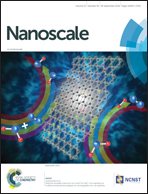Laser-induced remote release in vivo in C. elegans from novel silver nanoparticles-alginate hydrogel shells†
Abstract
Non-destructive, controllable, remote light-induced release inside cells enables studying time- and space-specific processes in biology. In this work we demonstrate the remote release of tagged proteins in Caenorhabditis elegans (C. elegans) worms using a near-infrared laser light as a trigger from novel hydrogel shells functionalized with silver nanoparticles responsive to laser light. A new type of hydrogel shells was developed capable of withstanding prolonged storage in the lyophilized state to enable the uptake of the shell by worms, which takes place on an agar plate under standard culture conditions. Uptake of the shells by C. elegans was confirmed using confocal laser scanning microscopy, while release from alginate shells in C. elegans and the laser effect on the shells on a substrate in air was followed using fluorescence microscopy. In addition, Raman microscopy was used to track the localization of particles to avoid the influence of autofluorescence. Hierarchical cluster spectral analysis is used to extract information about the biochemical composition of an area of a nematode containing the hydrogel shells, whose Raman signal is enhanced by the SERS (Surface Enhanced Raman Scattering) effect due to hot spots formed by silver nanoparticles present in the shells. The in vivo release demonstrated here can be used to study intestinal microbiota and probiotic compounds as well as a possible future strategy for gene delivery in the worms, other insects and other organisms.



 Please wait while we load your content...
Please wait while we load your content...